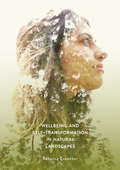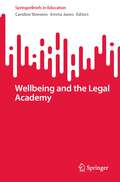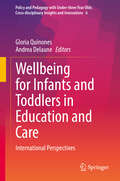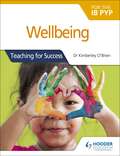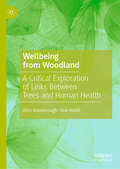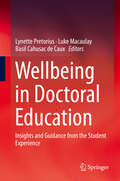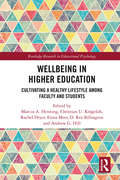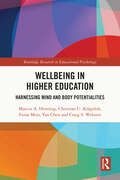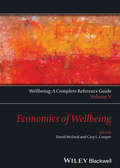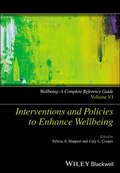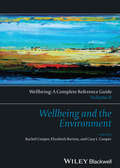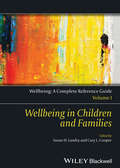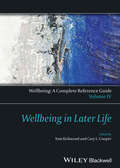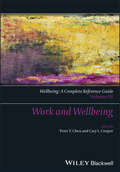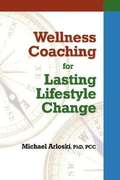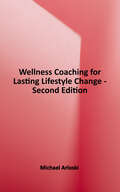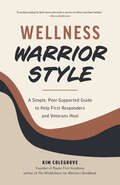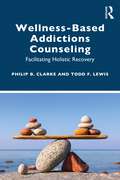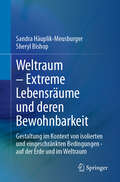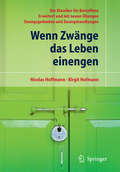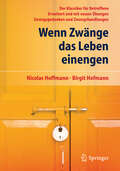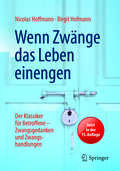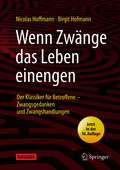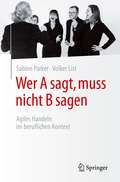- Table View
- List View
Wellbeing and Self-Transformation in Natural Landscapes
by Rebecca CrowtherThis book explores how natural landscapes are linked to positive mental wellbeing. While natural landscapes have long been represented and portrayed as transformative, the link to mental wellbeing is an area that researchers are still aiming to comprehend. Accompanying five groups of people to rural Scotland, the author considers individual, external and group motivations for journeying from urban environments, examining in what ways these excursions are personally and socially transformative. Far more than traversing mere physical boundaries, this book illustrates the new challenges, experiences, territories and cultures provided by these excursions, firmly anchored in the Scottish countryside. In doing so, the author questions the extent to which people’s own narratives link to the perception that the outdoors are positively transformative – and what indeed does have the power to influence transformation. Grounded in extensive qualitative research, this contemplative and ethnographic book will be of interest and value to students and scholars of the outdoors and its connection to wellbeing.
Wellbeing and the Legal Academy (SpringerBriefs in Education)
by Emma Jones Caroline StrevensThis book provides a novel contribution to the wider bodies of literature on student and academic wellbeing by including a series of rich and nuanced discussions of specific aspects of the wellbeing of legal academics. It contains original research contributions on this topic drawing on insights from law, education and psychology and throws a spotlight on an emerging field of interest. In particular, it focuses attention on the need to understand the implications of workload, communication, competence, and community for academic wellbeing with the collection providing insight as to the amelioration of stress linked to these themes. Reference will be made to the key factors which influence each of these themes, such as the neo-liberal academy, the contours and staffing of the law school, the impact of COVID-19 and the role of values and ethics. Relevant theoretical perspectives relating to these themes, including self-determination theory and the notion of an ethic of care, will also be discussed.
Wellbeing for Infants and Toddlers in Education and Care: International Perspectives (Policy and Pedagogy with Under-three Year Olds: Cross-disciplinary Insights and Innovations #6)
by Gloria Quinones Andrea DelauneThis collection explores key issues related to infant and toddler wellbeing, offering diverse international perspectives on how wellbeing is culturally understood. Scholars from Drawing from Australia, Aotearoa (New Zealand), Brazil, Greece, Norway, Portugal and the UK present local conceptualizations that contribute to a broader, global understanding of wellbeing. The international contributors examine wellbeing as a crucial construct, emphasising the importance of relationships, health, emotions, imagination, and professional practice in infant-toddler education. Their research covers various topics, including transitions, peer relationships, love, interactions with objects and environments, conceptualisations of time, pedagogical weaving, Indigenous knowledge, and intra-connectedness. This book highlights the significance of relationships—between people, places, objects, and time—in shaping wellbeing. It challenges readers to reconsider wellbeing as both central to pedagogy and deeply interconnected with humans, non-humans, and vibrant environments. Drawing on diverse theoretical frameworks and research projects, the collection offers rich, multifaceted insights into wellbeing across varied contexts.
Wellbeing for the IB PYP: Teaching for Success
by Dr Kimberley O'BrienTeach for success and implement effective strategies to create flexible, inviting and intentional learning spaces - essential for supporting physical and emotional wellbeing. - Offers guidance on how to support emotional wellbeing with dedicated chapters on Mindfulness, anxiety and stress and the importance of wellbeing and PSEL. - Helps develop fully rounded and responsible learners with exploration of the lB Learner Profile and ATL skills of social, communication and self-management skills with case studies and Dr Kimberley's Top 5 Tips. - Provides a collaborative approach to wellbeing with storybooks (PYP Friends) and workbooks (PYP ATL Skills Workbooks) that can be used alongside this resource to develop your students social and emotional wellbeing.
Wellbeing for the IB PYP: Teaching for Success
by Kimberley O'BrienTeach for success and implement effective strategies to create flexible, inviting and intentional learning spaces - essential for supporting physical and emotional wellbeing. - Offers guidance on how to support emotional wellbeing with dedicated chapters on Mindfulness, anxiety and stress and the importance of wellbeing and PSEL. - Helps develop fully rounded and responsible learners with exploration of the lB Learner Profile and ATL skills of social, communication and self-management skills with case studies and Dr Kimberley's Top 5 Tips. - Provides a collaborative approach to wellbeing with storybooks (PYP Friends) and workbooks (PYP ATL Skills Workbooks) that can be used alongside this resource to develop your students social and emotional wellbeing.
Wellbeing from Woodland: A Critical Exploration of Links Between Trees and Human Health
by Sue Waite Alice GoodenoughThis book provides a framework for understanding the components of woodland wellbeing. Based around the collaborative project, Good from Woods, the book spotlights multiple case studies to explore how wellbeing and health are promoted in woodland settings and through woodland inspired activity. It illustrates forms of wellbeing through real examples of woodland practice and draws out implications for the design of programmes to support health and wellbeing across different client groups. Chapters discuss health and wellbeing from a variety of perspectives such as psychological, physical, social, emotional and biophilic wellbeing.The book will be of great practical use to commissioners, providers and users of woodland based activity who want to take a deeper look into how trees, woods and forests support human health and happiness, as well as of interest to academics and students engaged in research in outdoor activities, urban forestry and natural health and wellbeing.
Wellbeing in Doctoral Education: Insights and Guidance from the Student Experience
by Lynette Pretorius Luke Macaulay Basil Cahusac de CauxThis book offers a range of personal and engaging stories that highlight the diverse voices of doctoral students as they explore their own learning journeys. Through these stories, doctoral students call for an academic environment in which the discipline-specific knowledge gained during their PhD is developed in concert with the skills needed to maintain personal wellbeing, purposely reflect on experiences, and build intercultural competence. In recent years, wellbeing has been increasingly recognised as an important aspect of doctoral education. Yet, few resources exist to help those who support doctoral students. Wellbeing in Doctoral Education provides a voice for doctoral students to advocate for improvements to their own educational environment. Both the struggles and the strategies for success highlighted by the students are, therefore, invaluable not only for the students themselves, but also their families, their social networks, and academia more broadly. Importantly, the doctoral students’ stories should be a clarion call for those in decision-making positions in academia. These narratives demonstrate that it is imperative that academic institutions invest in providing the skills and support that doctoral students need to succeed academically and flourish emotionally.
Wellbeing in Higher Education: Cultivating a Healthy Lifestyle Among Faculty and Students (Routledge Research in Educational Psychology)
by Marcus A. Henning Christian U. Krägeloh Rachel Dryer Fiona Moir Rex Billington Andrew G. HillAcademic staff and students within higher education settings are confronted by a learning environment that is academically stimulating, informative, career-focused and socially rich, which can be intensely competitive and highly charged. Within this learning environment, academic staff and students are often at risk of compromising their wellbeing in their pursuit of academic excellence. This book provides an examination of the key areas that are important to the sustenance of wellbeing within higher education settings, with a view to promoting healthy learning environments. The chapter authors are predominantly working in the Asia-Pacific rim, but the book also includes more universal perspectives. The synthesis of the issues covered in the book is crucial to the understanding of higher education as not only an environment for gaining knowledge and skills relevant for success in academic and career domains, but also as an environment for developing socially adept and authentic communication skills. The ideas presented in this book will further assist academic staff and students to consider ways to more fully participate in their learning environment so that they can optimize their valuable contributions to the professional communities they serve.
Wellbeing in Higher Education: Harnessing Mind and Body Potentialities (Routledge Research in Educational Psychology)
by Yan Chen Marcus A. Henning Christian U. Krägeloh Fiona Moir Craig S. WebsterDrawing on holistic research and professional practice, this book provides rich empirical, scientific, and clinical lenses to the discourse on wellbeing in higher education. The authors have appraised the underlying, conceptual, empirical, and applied nature of existing mind-body programmes often utilized to cultivate wellbeing (e.g., seated meditation, yoga, Taijiquan, Pilates, Feldenkrais, biofeedback, and the Alexander technique). Higher education is touted as a sector that develops new ideas for the wider community as well as ensuring students are provided with the skills, knowledge, and attitudes to positively contribute to the wider community. Within this setting, there are numerous benefits (e.g., attaining a reputable qualification), but there are also risks (e.g., stressors associated with expectations). To ensure the higher education setting is a place of wellbeing in addition to achievement, several strategies are promoted to assist staff and students whilst working and studying. Chapters offer clear implications for research and practice, and explore effective strategies for enhancing wellbeing for students and staff. The integrative mind-body programmes have considerable potential for developing wellbeing in the higher education settings. As such, this book will appeal to academics and researchers in the higher education sector, including scholar-practitioners, and teacher educators.
Wellbeing: A Complete Reference Guide, Economics of Wellbeing
by Cary L. Cooper David McDaidPart of the six-volume Wellbeing: A Complete Reference Guide, this is a comprehensive look at the economics of wellbeing with coverage of history, research, policy, and practice. Examines the challenges inherent in studying and measuring wellbeing from an economic perspective Discusses strategies and interventions to improve wellbeing across the lifespan and in different settings Addresses the potential economic benefits for governments and policymakers of actively investing in initiatives to improve wellbeing, from the workplace to the home to the natural environment Emphasizes the need to strengthen the evidence base for the economics of wellbeing and improve methods for translating research into policy and practice
Wellbeing: A Complete Reference Guide, Interventions and Policies to Enhance Wellbeing
by Cary L. Cooper Felicia A. HuppertUsing an evidence-based approach and case studies from a wide range of life domains, Interventions and Policies to Enhance Wellbeing examines the most successful existing strategies to promote wellbeing and mental health. Discusses the results of the latest research in the science of wellbeing and their implications for improved learning, creativity, productivity, relationships, and health Covers interventions for individuals across the lifespan, as well as those for organizations, communities, and entire populations Looks at policy initiatives and approaches with a focus on the integration of new technology and the role of the media Part of the six-volume Wellbeing: A Complete Reference Guide, which brings together leading research from across the social sciences
Wellbeing: A Complete Reference Guide, Wellbeing and the Environment
by Cary L. Cooper Rachel Cooper Elizabeth BurtonPart of the six-volume Wellbeing: A Complete Reference Guide, this volume examines the ways in which the built environment can affect and enhance the wellbeing of society. Explores the effects of environment on wellbeing and provides insight and guidance for designing, creating, or providing environments that improve wellbeing Looks at the social and health issues surrounding sustainable energy and sustainable communities, and how those connect to concepts of wellbeing Brings the evidence base for environmental wellbeing into one volume from across disciplines including urban planning, psychology, sociology, healthcare, architecture, and more Part of the six-volume set Wellbeing: A Complete Reference Guide, which brings together leading research on wellbeing from across the social sciences
Wellbeing: A Complete Reference Guide, Wellbeing in Children and Families
by Cary Cooper Susan H. LandryThis is a wide-ranging look at the factors which positively and negatively affect the wellbeing of children and families. Discusses core developmental competencies for later life, the role of the family, the impact of different settings, and factors associated with lower levels of wellbeing Brings together the latest research from leaders in the field of child development Outlines important recommendations for families, caregivers, educators, social workers, and policymakers to assure and increase child wellbeing Part of the six-volume Wellbeing: A Complete Reference Guide, which brings together leading research from across the social sciences
Wellbeing: A Complete Reference Guide, Wellbeing in Later Life
by Cary L. Cooper Thomas B. L. KirkwoodWellbeing in Later Life uses the latest research from a variety of disciplines to address and correct common myths and misconceptions about aging. Covers topics ranging from biological mechanisms that affect aging to lifestyle, attitudes, and social factors Examines the challenges of humanity’s increasing life expectancy and includes recommendations for maintaining and enhancing wellbeing in later life Makes meaningful connections between research and practice to link aspects of aging which have previously been considered separate Part of the six-volume Wellbeing: A Complete Reference Guide, which brings together leading research from across the social sciences
Wellbeing: A Complete Reference Guide, Work and Wellbeing
by Cary L. Cooper Peter Y. ChenPart of the six-volume reference set Wellbeing: A Complete Reference Guide, this volume is a comprehensive look at wellbeing in the workplace at organizational, managerial, and individual levels. Discusses the implications of theory and practice in the field of workplace wellbeing Incorporates not only coverage of workplace stress in relation to wellbeing, but also aspects of positive psychology Explores the role of governments in promoting work place well being Part of the six-volume set Wellbeing: A Complete Reference Guide, which brings together leading research on wellbeing from across the social sciences Topics include work-life balance; coping strategies and characters of individuals; characteristics of workplaces and organizational strategies that are conducive to wellbeing; and many more
Wellness Coaching for Lasting Lifestyle Change
by Michael ArloskiFor the first time the principles of wellness promotion and personal life coaching are brought together in one volume. Guided by his long experience as a wellness coach, Dr. Arloski blends the wisdom of the coaching profession to bring us an easy-to-use training tool perfect for: wellness professionals, professional coaches, managers, EAP professionals, counselors, and wellness educators. The coaching processes outlined in the book will help you work with your clients to empower them to draw on his or her own abilities and resources to make lasting changes for better health.
Wellness Coaching for Lasting Lifestyle Change
by Michael ArloskiGuided by his long experience as a wellness coach, Dr. Arloski blends the wisdom of the wellness field and the proven processes of the coaching profession to bring us an easy-to-use training tool, perfect for wellness professionals, life coaches, disease management professionals, wellness coach training, EAP professionals and therapists.
Wellness Warrior Style: A Simple, Peer-Supported Guide to Help First Responders and Veterans Heal
by Kim ColegroveA Warrior’s Roadmap to Healing Trauma “A book that will save lives and a book about those who save lives.”—Belles and RebellesWork stress relief—even after retirement—for first responders, veterans, service members, or others. Hear from warriors who credit author Kim Colegrove’s first book for saving their lives, and discover proven techniques and peer support to conquer long term effects of stress and restore your well-being as a resilient warrior.Reclaim your resilience and restore well-being. Wellness Warrior Style focuses on the unique challenges faced by those on the frontlines and offers support for all of society’s warriors, protectors, guardians, and healers. Understand the long term effects of stress, PTS (Post-Traumatic Stress), and find work stress relief tailored for first responders.Healing trauma for first responders. Whether you're a police officer, firefighter, emergency medical responder, mental health crisis worker, service member, warfighter supporter, veteran, or anyone else in public safety and service, take off your armor and set aside your shield. Let’s tackle these issues together.Inside, find:Personal stories from your peers, offering a sense of camaraderiePeer-supported resources, including culturally-relevant curriculum created by fellow warriors on Kim’s online platform, Pause First AcademyStrategies to help you navigate chronic stress with resilience and strengthHow to ask for help—and the importance of doing soIf you have read Walk the Blue Line, The Myth of Normal, or Nothing's Wrong, you’ll love Wellness Warrior Style.
Wellness-Based Addictions Counseling: Facilitating Holistic Recovery
by Todd F. Lewis Philip B. ClarkeThis book presents a culture change in addictions treatment that places wellness at the forefront of relapse, addiction, and recovery. The authors introduce a wellness-based conceptualization of addiction and recovery including the wellness model that grounds Wellness-Based Addictions Counseling (WBAC) and the techniques of this approach. Wellness-Based Addictions Counseling advocates for wellness as the primary variable in addiction and recovery outcomes, presents a wellness-based model of addiction and recovery, and highlights techniques for unlocking the motivational and strength-based aspects of this approach. Specifically, the authors provide wellness questions and screening tools to incorporate into the clinical evaluation and structure for creating a wellness plan and family wellness plan for the client’s loved ones. Readers will learn numerous wellness-based techniques related to the mind, body, spirit, emotions, and connection that can prevent relapse and facilitate well-being. All WBAC interventions are grounded in developmental, culturally responsive, and strength-based perspectives. Wellness-Based Addictions Counseling is essential reading for professionals who provide addictions treatment and counseling as well as scholars who conduct writing and research on addiction.
Weltraum – Extreme Lebensräume und deren Bewohnbarkeit: Gestaltung im Kontext von isolierten und eingeschränkten Bedingungen - auf der Erde und im Weltraum
by Sandra Häuplik-Meusburger Sheryl BishopDieses Buch erforscht kreative Lösungen für die einzigartigen Herausforderungen, die mit der Gestaltung bewohnbarer Räume in extra-terrestrischen Umgebungen verbunden sind. Ziel ist es, einen konstruktiven Dialog zwischen den Forschern und Planern zukünftiger (Weltraum-)Lebensräume zu fördern. Die Autoren untersuchen die verschiedenen Konzepte des Begriffs Habitability [auf Deutsch Bewohnbarkeit] aus der Perspektive der Bewohner sowie der Planer und Sozialwissenschaften. Das Buch gibt einen Überblick über die Entwicklung und die Fortschritte in der Gestaltung von Lebensräumen für bemannte Raumfahrzeuge und -habitate, und inkludiert auch analoge Forschungs- und Simulationseinrichtungen in extremen Umgebungen auf der Erde. Es zeigt auf, wie verschiedene Konzepte der Habitabilität gestalterisch umgesetzt wurden und welche noch fehlen. Der Schwerpunkt dieses Buches liegt auf der Identifizierung der wesentlichen Faktoren und kreativer Lösungen zur Schaffung von Lebensräumen, in denen sich Menschen wohlfühlen. Ausgewählte Aspekte werden vor einem sozial-räumlichen fachlichen Hintergrund diskutiert und mögliche Anwendungen aufgezeigt. Human Factors und Habitability Design sind wichtige Themen für jedwede Arbeits- und Lebensräume. Für die bemannte Erforschung des Weltraums sind sie von entscheidender Bedeutung. Zwar wurden menschliche Faktoren und bestimmte Aspekte der Bewohnbarkeit in den Entwurfsprozess von bemannten Raumfahrzeugen integriert, doch besteht die Dringlichkeit von der reinen funktionalen Überlebensfähigkeit, in ein den Menschen unterstützendes Design überzugehen. Seit einigen Jahren anerkennt die NASA das Risiko eines inkompatiblen Fahrzeug- oder Habitatdesigns als ein Hauptrisiko für die menschliche Gesundheit und Leistungsfähigkeit im Weltraum an. Die Bewohnbarkeit und die menschlichen Faktoren werden für die Gestaltung künftiger langfristiger und kommerzieller Weltraumeinrichtungen noch wichtiger werden, wenn größere und unterschiedlichere Gruppen Lebensräume außerhalb der Erde nutzen. Das Buch wird nicht nur Personen und Organisationen zugutekommen, die für bemannte Raumfahrtmissionen und Missionssimulatoren verantwortlich sind, sondern bietet auch relevante Informationen für Gestalter terrestrischer rauer Umgebungen (z. B. abgelegene Betriebs- und Forschungseinrichtungen, Krankenhäuser, Gefängnisse, Produktionsstätten). Darüber hinaus werden Erkenntnisse über die sozio-räumliche Beziehung vorgestellt, die für Sozialwissenschaftler, Ingenieure und Architekten im Allgemeinen von Interesse sind. Inhaltsverzeichnis Kurz : 1. Einleitung.- 2. Habitability / Bewohnbarkeit: Vom ORT zum (Lebens) RAUM.- 3. Bewohnbarkeit als (Lebens) RAUM.- 4. Rezension: Studien zur Bewohnbarkeit und Architektur von Mockups und simulierten Umgebungen.- 5. Rezension: Studien zur Bewohnbarkeit und Architektur in In-Situ-Umgebungen.- 6. Projektionen.- 7. Blick in die Zukunft: Wie man eine Blechbüchse in ein Zuhause verwandelt: Lösungen für ausgewählte Dimensionen der (sozialräumlichen) Bewohnbarkeit.
Wenn Zwänge das Leben einengen
by Nicolas Hoffmann Birgit HofmannWenn Zwänge das Leben einengen Zwangsgedanken und Zwangshandlungen können das Leben völlig lähmen oder ersticken. Von Angst- oder Ekelgefühlen getrieben, sieht sich der Betroffene gezwungen, die schrecklichsten Gedanken zu denken oder die unsinnigsten Handlungen auszuführen. So kommt es zu endlosen oder zeitraubenden Kontrollen, etwa ob die elektrischen Geräte ausgeschaltet sind. Oder der Betroffene verbringt sehr viel Zeit damit, seine Hände von vermeintlich gefährlichen Bakterien zu befreien. Ursachen, Behandlungsmethoden und Möglichkeiten der Selbsthilfe Die Autoren zeigen in ihrem Buch, wie Zwangserkrankungen entstehen welche Formen von Zwangserkrankungen es gibt welche Möglichkeiten die moderne Psychotherapie bietet, sich allein oder mit Unterstützung eines Therapeuten von diesen lästigen Ritualen zu befreien wie man als Angehöriger seinem Partner helfen kann. Geschrieben für Zwangskranke und ihre Angehörigen, für Therapeuten und Berater, die dieses Buch ihren Klienten empfehlen können, sowie für alle Interessierte. Der Klassiker für Betroffene - erweitert und mit neuen Übungen
Wenn Zwänge das Leben einengen
by Nicolas Hoffmann Birgit HofmannDer Klassiker für Betroffene - erweitert und mit neuen Übungen: Zwangsgedanken und Zwangshandlungen können das Leben völlig lähmen oder ersticken. Von Angst- oder Ekelgefühlen getrieben, sieht sich der Betroffene gezwungen, die schrecklichsten Gedanken zu denken oder die unsinnigsten Handlungen auszuführen. So kommt es zu endlosen oder zeitraubenden Kontrollen, etwa ob die elektrischen Geräte ausgeschaltet sind. Oder der Betroffene verbringt sehr viel Zeit damit, seine Hände von vermeintlich gefährlichen Bakterien zu befreien. Geschrieben für Zwangskranke und ihre Angehörigen, für Therapeuten und Berater, die dieses Buch ihren Klienten empfehlen können, sowie für alle Interessierte.
Wenn Zwänge das Leben einengen
by Nicolas Hoffmann Birgit HofmannDieser Selbsthilfe-Klassiker (bereits in der 15. Auflage) zeigt Betroffenen und ihrem Umfeld, wie Zwangserkrankungen entstehen, welche Formen von Zwangserkrankungen es gibt, welche Möglichkeiten die moderne Psychotherapie bietet, sich allein oder mit Unterstützung eines Therapeuten von diesen lästigen Ritualen zu befreien und wie man als Angehöriger seinem Partner helfen kann.Zwangsgedanken und Zwangshandlungen können das Leben völlig lähmen oder ersticken. Von Angst- oder Ekelgefühlen getrieben, sieht sich der Betroffene gezwungen, die schrecklichsten Gedanken zu denken oder die unsinnigsten Handlungen auszuführen. So kommt es zu endlosen oder zeitraubenden Kontrollen, etwa ob die elektrischen Geräte ausgeschaltet sind. Oder der Betroffene verbringt sehr viel Zeit damit, seine Hände von vermeintlich gefährlichen Bakterien zu befreien. In diesem Klassiker für Betroffene wird Hilfe greifbar.
Wenn Zwänge das Leben einengen: Der Klassiker für Betroffene - Zwangsgedanken und Zwangshandlungen
by Nicolas Hoffmann Birgit HofmannDieser Selbsthilfe-Klassiker (bereits in der 16. Auflage) zeigt Betroffenen und ihrem Umfeld, wie Zwangserkrankungen entstehen, welche Formen von Zwangserkrankungen es gibt, welche Möglichkeiten die moderne Psychotherapie bietet, sich allein oder mit Unterstützung eines Therapeuten von diesen lästigen Ritualen zu befreien, und wie man als Angehöriger seinem Partner helfen kann. Zwangsgedanken und Zwangshandlungen können das Leben völlig lähmen oder ersticken. Von Angst- oder Ekelgefühlen getrieben, sieht sich der Betroffene gezwungen, die schrecklichsten Gedanken zu denken oder die unsinnigsten Handlungen auszuführen. So kommt es zu endlosen oder zeitraubenden Kontrollen, etwa ob die elektrischen Geräte ausgeschaltet sind. Oder der Betroffene verbringt sehr viel Zeit damit, seine Hände von vermeintlich gefährlichen Substanzen zu befreien. In diesem Klassiker für Betroffene wird Hilfe greifbar. Geschrieben für ... Zwangskranke und ihre Angehörigen, für Therapeuten und Berater, die dieses Buch ihren Klienten empfehlen können, sowie für alle Interessierten. Die Autoren: Dr. phil. Nicolas Hoffmann ist einer der ersten deutschen Verhaltenstherapeuten und seit über 40 Jahren Dozent und Supervisor. Er ist Gründungsvorsitzender des Institutes für Verhaltenstherapie Berlin. Autor und Herausgeber zahlreicher Fachbücher. Dr. rer. nat. Birgit Hofmann ist Psychologische Psychotherapeutin (Verhaltenstherapie) in freier Praxis und Dozentin. Ehemalige Mitarbeiterin in Forschungsprojekten an der Universität Potsdam. Autorin mehrerer Fachbücher.
Wer A sagt, muss nicht B sagen: Agiles Handeln im beruflichen Kontext
by Volker List Sabine ParkerWer A sagt, muss nicht B sagen. Agiles Handeln im beruflichen KontextAgiles Handeln ist eine Lösungsoption, um unsichere und dynamische Zeiten erfolgreich zu meistern. In diesem Buch erfahren Sie Schritt für Schritt, wie Sie mit bestehenden Herausforderungen durch eine agile Haltung besser umgehen können. Doch wie wird man agil? Wie kann agiles Handeln gelernt werden? In diesem Buch finden Sie einen Weg, wie man Agilität erfahrungsorientiert entwickeln kann. Gewürzt mit einer kräftigen Prise Humor durch zahlreiche Karikaturen legt das Autorenteam Parker und List ein gut verständliches Trainingskonzept vor, das sich individuell in jedes Handlungsfeld übertragen lässt. Die gekonnte Vermittlung der Inhalte macht dieses Buch zu einem Lesegenuss und unterstützt Sie, agiles Handeln direkt umzusetzen und erfolgreich und zukunftsorientiert anzuwenden. Die ZielgruppenPersonal- und Organisationsentwickler, Berater, Führungskräfte, Trainer, Lehrkräfte, Theaterschaffende, Erwachsenenbildner und alle, die in ihrem beruflichen Kontext Menschen unterrichten, entwickeln und beraten. Die Autoren Sabine Parker M.A. (*1967) ist Personalentwicklerin, Kultur- und Theaterpädagogin, Gründerin und geschäftsführende Gesellschafterin der aisthetos akademie. Ihre Schwerpunkte sind die Personalentwicklung mit handlungsorientierten Methoden sowie die Ausbildung von Theaterpädagogen und Lehrkräften. Sie berät, trainiert und begleitet Menschen, Organisationen und Teams auf dem Weg zu mehr Kreativität und Agilität. Volker List (*1951) ist Doktor der Philosophie, Germanist, Politikwissenschaftler, Pädagoge, Business-Coach, Gründer der Forschungseinrichtung Angewandte Theaterforschung und Autor zahlreicher Publikationen. Seine Schwerpunkte sind die Gestaltung von Change-Prozessen mit kreativen Methoden, Rhetorik- und Präsentationstrainings sowie die Entwicklung innovativer Lernkonzepte.
